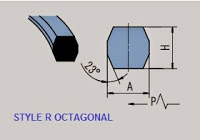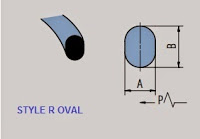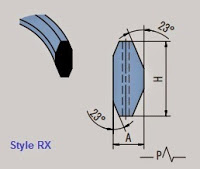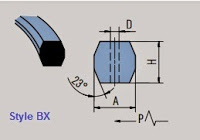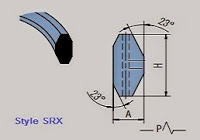PRODUCT CATEGORY
CONTACT US
- Tel: 0086-311-89642206
- Fax: 0086-311-67906676
- Mobile: 0086-15076331069 13933856228
- E-mail: sales@hbmetals.com
- E-mail: info@hbmetals.com
Metallic Ring-Joint Gaskets
1. General Introduction
Originated from the boiler field, ring joint gaskets are widely used in RTJ-face flange connections. They have steady performance in high-pressure & elevated temperature services and are commonly used for ASME class 900 and above. The ring joint gaskets are very robust. Both grooves of mating flanges and the ring which require a smooth, mirror-like finish should be precisely machined so that the ring can fit into the groove correctly. When tightening the bolts of the flange connection, the ring gasket deforms at the base resulting in a very effective seal. Although slightly deformation takes place during this process, the actual flange faces never touch when the bolts are tightened. Usually, the ring joint gasket has less hardness than the mating flanges which ensures that the gasket deforms other than the face of the flange.
2. Materials
Ring joint gaskets can be made from a wide selection of materials including soft iron, chromium-molybdenum alloy steel, stainless steel and non-ferrous metals(Monel, Hastelloy, Inconel and Titanium, etc). The material specification and hardness properties of ring gaskets should suit the process media, pressure rating and temperature.
3. Design & Manufacture Standards
Ring-joint gaskets are usually designed and manufactured in accordance with ASME B16.20 and API Specification 6A to suit ASME B16.5, ASME B16.47 Series A & Series B, API 6A Type 6B and 6BX flanges. Also in European standard, ring-joint gaskets are defined as per BS4865 / EN1514 to suit BS4504 and EN/DIN flanges.
4. Basic Types of Ring Joint Gaskets
The cross section of a ring joint gasket can be either oval or octagonal. Standard ring-joint gaskets can be categorized into three groups: Style R, Style RX and Style BX. And we also have the adaptation of Style SRX and SBX.
Style R can be either oval or octagonal types and both types are interchangeable in modern flat-bottomed grooves. Especially, only oval types can be used in round-bottom grooves in old flange connections. Style R ring-joint gaskets are designed to seal pressure up to 6250 psi(425 bar) in accordance with ASME B16.5 ratings and up to 5000 psi(340 bar) in accordance with API 6A pressure ratings.
Style R can be either oval or octagonal types and both types are interchangeable in modern flat-bottomed grooves. Especially, only oval types can be used in round-bottom grooves in old flange connections. Style R ring-joint gaskets are designed to seal pressure up to 6250 psi(425 bar) in accordance with ASME B16.5 ratings and up to 5000 psi(340 bar) in accordance with API 6A pressure ratings.
Style RX has a non-symmetrical octagonal cross section. This non-symmetrical geometry provides an unbalanced contact with the flange groove resulting in an effective pressure-energized sealing which is also called "self-sealing". RX ring-joint gaskets must be used in flat-bottomed grooves with a designed pressure up to approximate 10000 psi(700 bar). Since the style RX has a larger height than a style R, the make-up distance between two mating flanges are bigger.
Style BX has a symmetrical octagonal cross section. In addition, it incorporates a pressure passage hole to balance the pressures each side of the sealing surfaces. Style BX ring-joint gaskets should also be only used with flat-bottomed grooves. Usually they are designed to suit API 6A Type 6BX flanges with a design pressure up to 20000 psi(1360 bar). The short height of style BX allows face-to-face contact of mating flanges.
Both Style SRX and Style SBX are adaptations of style RX and style BX by incorporating a bypass venting hole allowing fluids trapped behind the ring gasket to escape into the line. Usually they are designed & manufactured to API Specification 17D for subsea underwater applications.
Dimensions of ASME B16.20 Ring-Joint Gaskets
|
ASME B16.20 METALLIC RING-JOINT GASKETS
|
|||||
5. Production Process
The production of metallic ring-joint gaskets takes a few steps: 1) Raw material preparation (billets or bars). 2) Forging. 3) Heat treatment. 4) Semi-finished products inspection. 5) Machining. 6) Final inspection(chemical analysis and mechanical test). 7) Stamping and packaging. 8) Stock into warehouse.
Views: Author:hbmetals Date:15/05/21










